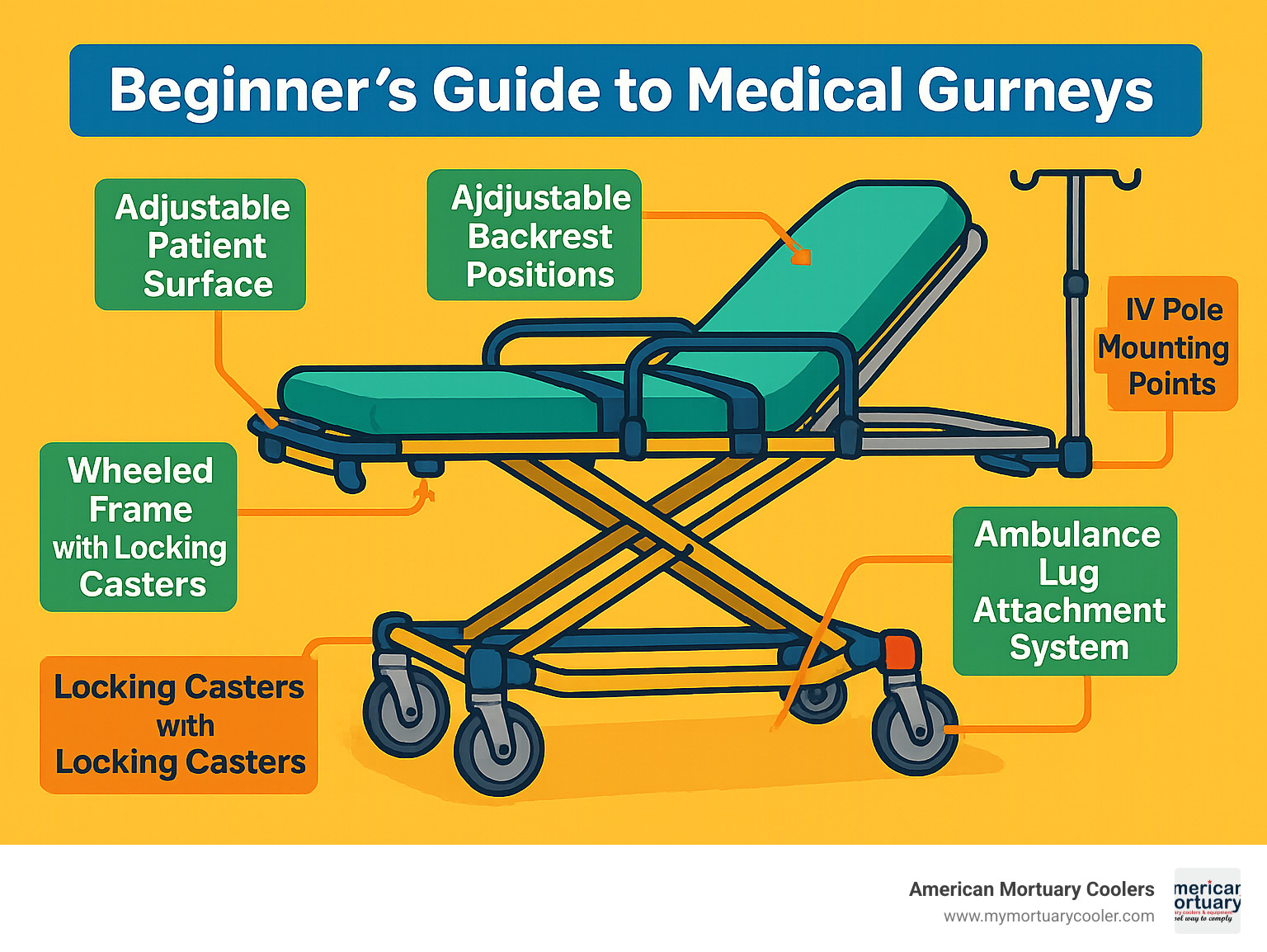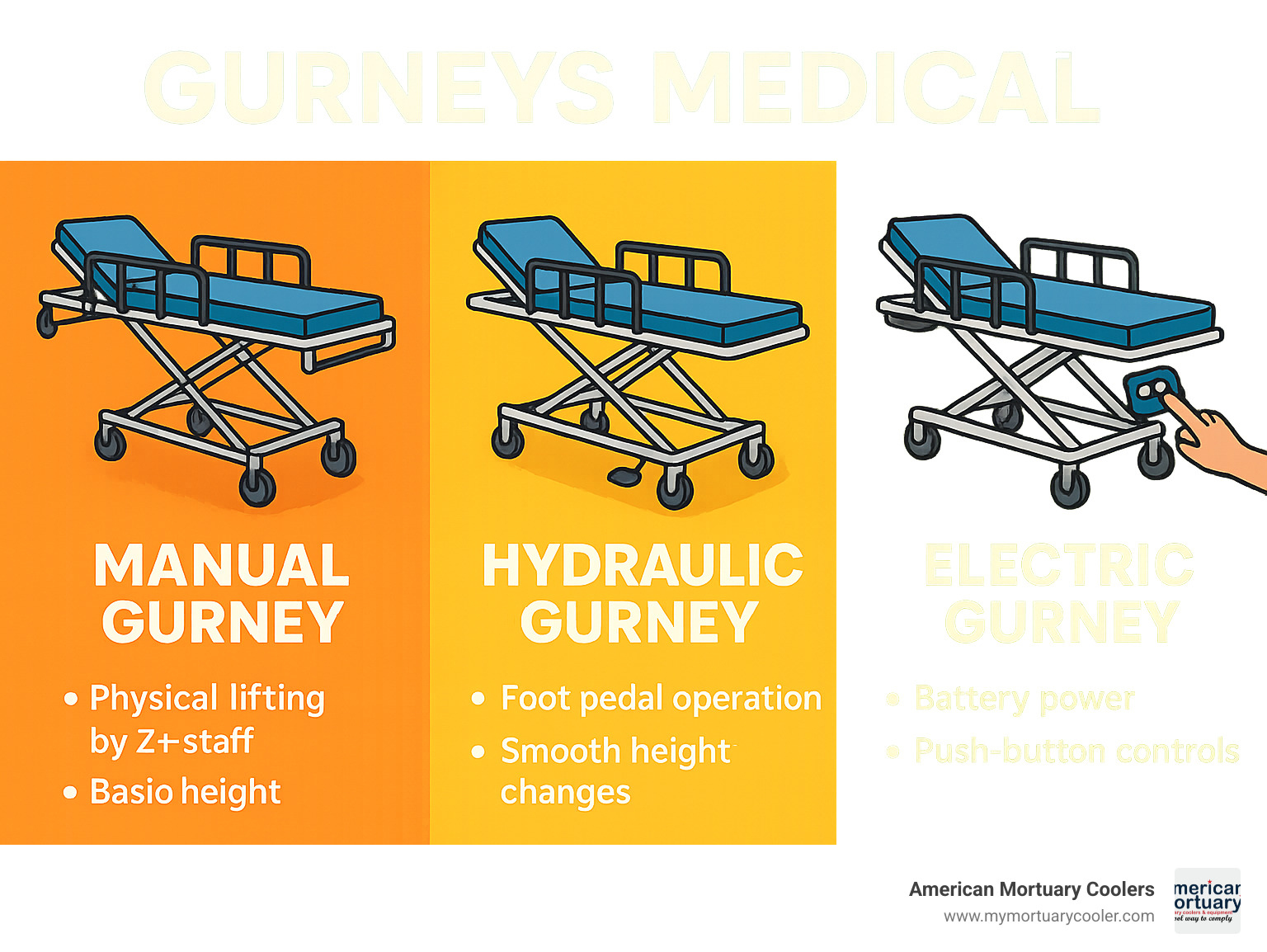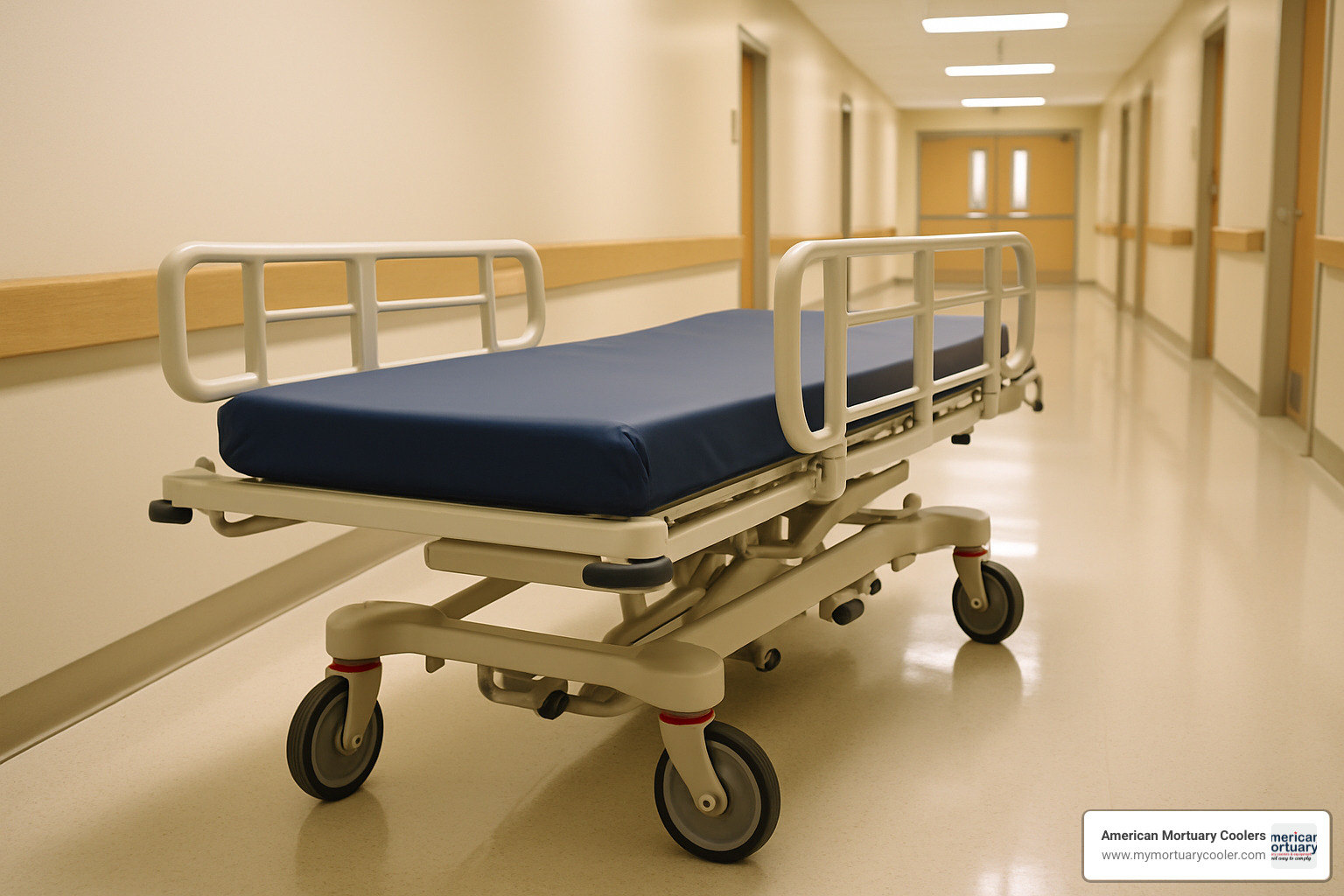
Beginner's Guide to Medical Gurneys
Why Understanding Gurneys Medical Is Essential for Healthcare Facilities
Gurneys medical equipment serves as the backbone of patient transport in hospitals, ambulances, and emergency care facilities. These wheeled stretchers enable safe, comfortable movement of patients who cannot walk or sit in standard wheelchairs.
Quick Answer for Healthcare Professionals:
- Definition: Wheeled stretchers with adjustable height and safety features
- Weight Capacity: 350-1,000+ lbs depending on model type
- Main Types: Manual, hydraulic, electric, and bariatric options
- Price Range: $22 for basic models to $1,700+ for advanced units
- Key Features: Locking wheels, side rails, adjustable backrests, IV pole mounts
Modern portable gurneys support weights ranging from 350 lbs to 600 lbs, with bariatric models handling up to 1,000 lbs. The most affordable emergency transport gurneys start at $21.95, while advanced ambulance models can cost over $1,700.
A gurney differs from basic stretchers through its wheeled frame with variable height adjustment. Unlike simple cots that require multiple people to carry, gurneys use swivel casters and locking mechanisms for controlled movement. They include integrated safety features like side rails, patient restraints, and specialized lug systems that secure the unit during ambulance transport.
Battery-powered hydraulic systems have revolutionized gurney design by reducing caregiver strain. EMS personnel face high risk of back injury from repetitive lifting, which led to widespread adoption of power-assisted gurneys that automatically raise and lower patients.
As Mortuary Cooler with years of experience supplying durable medical equipment nationwide, I've seen how proper gurney selection impacts both patient care and facility operations. Understanding the differences between gurneys medical equipment types helps healthcare facilities make informed purchasing decisions that improve safety and efficiency.

Quick look at gurneys medical:
Understanding Gurneys Medical Basics
The term "gurney" first appeared in hospitals in the 1930s. While medical historians debate its origins, what matters is how these wheeled devices became essential to healthcare.
A gurneys medical device is a stretcher on wheels with variable-height mechanism, allowing healthcare workers to adjust patient positioning without strain. Unlike basic stretchers requiring multiple people to carry them, gurneys roll smoothly on wheeled frames.
Think of a gurney as the Swiss Army knife of patient transport, designed for moving patients who need medical care but can't walk independently. At American Mortuary Coolers, we've worked with healthcare facilities nationwide, and every facility relies on quality gurneys for daily operations.
Modern gurneys evolved based on real-world needs. Scientific research on stretcher ergonomics drives manufacturers to create better designs protecting both patients and healthcare workers. Studies show choosing the right gurney dramatically reduces workplace injuries among medical staff.
How a Gurney Differs from Other Stretchers
Basic stretchers are simple canvas or tubular frame designs requiring two or more people to carry. They're great for emergencies but lack the mobility that makes gurneys useful for ongoing patient care.
Scoop stretchers split apart at both ends to slide under patients without rolling them over. While fantastic for trauma situations, they don't provide wheeled transport capabilities.
Flexible stretchers like the Reeves sleeve use six handholds for multiple rescuers to carry patients through narrow spaces. Basket litters (Stokes stretchers) excel in wilderness rescue and helicopter evacuations but aren't practical for routine hospital transport.
Ambulance cots represent premium gurney design, including specialized lug and latch systems that lock securely during transport.
Key Components Every Beginner Should Know
Modern gurneys medical equipment combines several sophisticated components.
Frame construction forms the foundation. Aluminum frames offer lightweight portability, while steel construction provides maximum durability for high-volume facilities. Busy hospitals typically prefer steel frames for longevity.
Caster systems provide mobility. Quality swivel casters enable maneuvering around corners, while locking mechanisms keep everything steady during transfers.
Side rails serve as fall prevention barriers and secure handholds. They fold down for patient access and lock up for safety. Some models integrate height adjustment controls into the rails.
Adjustable backrests position patients from flat to nearly upright, essential for patients with breathing problems. The Trendelenburg position (head down, feet up) can be lifesaving for circulatory shock.
Patient restraint systems include adjustable straps and belts keeping patients secure without restricting medical access. IV pole mounting points and integrated storage provide space for monitors, intravenous equipment, and essential devices.
Types, Materials & Evolution of Gurneys Medical
The world of gurneys medical equipment has evolved dramatically from simple wheeled cots to today's sophisticated units. Modern materials science has revolutionized construction - aluminum alloy frames provide excellent strength-to-weight ratios, PVC components resist corrosion and simplify cleaning, while stainless steel elements ensure years of heavy use.
The real game-changer has been battery-powered hydraulic systems that automatically raise and lower patients, reducing physical strain on healthcare workers. Hospitals and ambulance services report significant drops in worker compensation claims after investing in powered gurneys.

Manual vs Hydraulic vs Electric Gurneys Medical
Manual gurneys use muscle power for all adjustments. They cost less upfront, making them attractive for budget-conscious facilities, but all that lifting takes a toll on staff over time.
Hydraulic gurneys offer a sweet spot for many facilities. Foot pedal operation raises and lowers patients smoothly without electrical components that might fail. Ambulance services prefer hydraulic systems for reliability and low maintenance.
Electric gurneys feature battery-powered operation with push-button controls making positioning effortless. These minimize physical demands on caregivers and provide precise control valuable during delicate procedures. Batteries typically last a full shift.
EMS adoption of battery-powered hydraulic gurneys addresses serious back injury problems among personnel. The investment in power-assist technology often pays for itself through reduced caregiver strain and improved efficiency.
Bariatric & Pediatric Solutions
Bariatric gurneys address changing patient populations with high-capacity construction supporting 700-1000 lb weight limits, wider decks and reinforced frames. Design goes beyond size - wider patient surfaces improve comfort and reduce pressure points, while comfort padding makes a difference for patients with mobility challenges.
Pediatric solutions scale everything down for children's safety. These units feature shorter lengths, narrower widths, and child-sizing that helps young patients feel secure. Many include colorful designs and friendly aesthetics reducing medical procedure anxiety.
Pediatric gurneys need special attention - adjustable side rail heights, smaller restraint systems, and compatibility with pediatric medical equipment. Some convert between transport and examination positions, providing versatility without requiring multiple equipment pieces.
Safety, Comfort & Regulatory Standards
When it comes to gurneys medical equipment, safety is literally a matter of life and death. Every gurney must meet strict standards protecting both patients and healthcare workers.
FDA oversees medical device regulations for healthcare gurneys, while ANSI/AAMI standards specify performance requirements. OSHA regulations focus on healthcare worker safety during operation. Compliance isn't optional for legal operation and insurance coverage.
Load ratings represent critical safety specifications. Modern gurneys display weight limits from 350 to 1,000 pounds. Exceeding limits can cause catastrophic failure. I recommend selecting gurneys with capacity margins above expected patient weights.
Brake systems must lock reliably every time. Unexpected rolling during patient transfer causes serious injuries. Quality brakes engage smoothly and hold firmly on various surfaces.
Infection control protocols require gurneys to withstand repeated cleaning between patients. Hospital-grade disinfectants must be compatible with gurney materials. Many facilities use disposable covers for additional protection.

EMS back injury statistics show why ergonomic design matters. Traditional manual lifting contributes to high injury rates among emergency personnel. Powered systems dramatically reduce injuries by eliminating repetitive heavy lifting.
More info about heavy-duty differences between medical and mortuary stretchers explains specialized requirements.
Top Safety Features in Gurneys Medical
Patient restraint systems balance fall prevention with medical access. Modern restraints use quick-release mechanisms enabling rapid patient access during emergencies while maintaining security during transport.
Ambulance lug systems ("antlers") provide secure connection between gurney and vehicle mounting systems, preventing dangerous movement during transport. Locking mechanisms must engage completely before vehicle movement.
Trendelenburg positioning allows head-down positioning lifesaving for circulatory shock patients. This requires robust locking mechanisms preventing accidental position changes.
X-ray compatibility features enable imaging without risky patient transfers. Radiolucent materials allow clear images while maintaining structural integrity.
Shock absorption systems protect patients from bumps and vibrations during transport, especially important for ambulance applications.
Cleaning & Maintenance Checklist
Daily cleaning protocols should include complete surface disinfection with hospital-grade cleaners, focusing on high-touch areas like side rails, controls, and restraints.
Caster maintenance requires regular lubrication and wear inspection. Damaged casters create operation difficulties and floor damage.
Battery maintenance for electric models needs consistent charging schedules and capacity testing. Follow manufacturer recommendations and keep spare batteries available.
Annual professional service provides deep inspection catching problems before failures. Maintain detailed service records for warranty compliance and regulatory documentation.
Buying & Ownership Guide for Healthcare Facilities
Choosing the right gurneys medical equipment starts with understanding your specific needs. After helping healthcare facilities nationwide, I've learned the key is knowing requirements before shopping.
Prices range from basic emergency transport gurneys at $22 to advanced ambulance models over $1,700. This range reflects real differences in capabilities and durability. A $22 gurney works for occasional clinic use but won't survive busy emergency department demands.
New versus refurbished decisions offer 40-50% cost savings with refurbished units, but you get limited warranty coverage and potentially shorter service life. New equipment provides full warranty protection and latest safety features.
Warranty coverage varies dramatically. Basic warranties cover manufacturing defects for one year, while premium warranties include parts and labor for several years. For high-use facilities, extended warranties often pay for themselves.
Don't forget shipping and handling costs. Gurneys require freight shipping with costs varying by location. American Mortuary Coolers provides direct delivery across the contiguous 48 states.
Financing options make quality equipment accessible through lease programs or extended payment terms, allowing better equipment while spreading costs.
More info about buying gurney beds provides detailed purchasing guidance.
Factors That Affect Cost of Gurneys Medical
Material construction creates the biggest cost differences. Aluminum frames cost more than steel but are lighter. Stainless steel components eliminate corrosion concerns. PVC elements keep costs down while simplifying cleaning.
Weight capacity requirements drive design and pricing. Standard 350-pound capacity gurneys use different materials than bariatric models rated for 1,000 pounds.
Powered features typically double costs compared to manual models but transform operations by eliminating physical strain and reducing injury risks.
Brand recognition affects pricing through quality and reliability reputations. Consider total ownership costs including maintenance, repairs, and replacement.
Compliance labeling and certifications add cost but provide essential legal protection. FDA-approved devices cost more but are required for healthcare applications.
Selecting the Right Model for Your Setting
Hospital transport applications need gurneys prioritizing patient comfort and staff efficiency. Look for smooth height adjustment and quiet casters.
Ambulance cot requirements demand rugged construction handling emergency conditions. Lug and latch mounting systems must meet emergency vehicle standards.
Extended stay positioning requires comfortable surfaces and multiple positioning options. Adjustable backrests and positioned side rails improve patient comfort.
Imaging compatibility requires radiolucent materials not interfering with X-ray or MRI procedures, eliminating patient transfer needs.
Bariatric clinic applications need high-capacity models with wider surfaces and reinforced construction. Consider current and future patient weight requirements.
Match gurney selection to operational needs. Busy emergency departments have different requirements than small outpatient clinics.
Frequently Asked Questions about Gurneys Medical
What is the typical weight capacity of modern gurneys?
When healthcare facilities ask about weight limits, I always start with the basics: standard gurneys medical equipment handles anywhere from 350 to 600 pounds safely. That covers most situations you'll encounter in daily operations.
But here's where it gets interesting - bariatric models push those limits much higher. We're talking about specialized units that can support up to 1,000 pounds, with some heavy-duty models going even beyond that range. The Patient Aid Portable Stretcher & Gurney has earned quite a reputation with its 4.9 out of 5-star rating from 92 reviews, and its 600-pound capacity hits that sweet spot for most facilities.
Weight capacity isn't just a number on a spec sheet. Exceeding those limits can spell disaster - mechanical failure, injured patients, hurt staff, and liability headaches nobody wants to deal with. That's why I always recommend choosing gurneys with some breathing room above your typical patient weights. Better safe than sorry, right?
How has gurney design reduced caregiver back injuries?
This is where modern technology really shines. Battery-powered hydraulic systems have been absolute game-changers for healthcare workers' safety. Think about it - EMS personnel used to face sky-high injury rates from constantly lifting and lowering patients manually. Those days are mostly behind us now.
Electric gurneys with push-button controls do the heavy lifting automatically. No more straining backs, no more team-lifting every single patient transfer. The technology provides precise positioning while keeping your staff healthy and happy. Facilities that've made the switch to powered gurneys tell us their worker compensation claims dropped significantly.
The improvements go beyond just the lifting mechanism too. Better caster systems roll smoother, improved handle positioning feels more natural, and improved maneuverability means less wrestling with stubborn equipment. Everyone wins - patients get gentler transport, and caregivers go home without aching backs.
What maintenance do gurneys require between patients?
Patient safety starts with proper cleaning, and gurneys medical equipment needs thorough attention between every single use. Hospital-grade disinfectants are your best friend here, along with disposable coverings that make the whole process faster and more effective.
Focus on the high-touch zones - side rails, controls, restraint systems, and anywhere hands naturally go during operation. These spots harbor germs and need extra attention during your cleaning routine.
Daily maintenance keeps everything running smoothly. Check those casters, test the brakes, and keep electric models charged and ready. Weekly inspections catch problems before they become headaches, while annual professional service ensures everything meets regulatory standards.
Here's the thing about maintenance logs - they're not just bureaucratic paperwork. Detailed records protect your warranty coverage and prove regulatory compliance when inspectors come calling. Train your staff on proper cleaning procedures and basic maintenance tasks. It prevents equipment damage and keeps operations running like clockwork.
Conclusion
Choosing the right gurneys medical equipment comes down to understanding your facility's specific needs and matching them with the right features. Whether you need a basic manual model for occasional use or a sophisticated electric unit for high-volume patient transport, the investment in quality equipment pays off through better patient care and happier staff.
After years of working with healthcare facilities across the country, we've seen how the right gurney selection transforms daily operations. A facility in Tennessee recently shared how upgrading to hydraulic gurneys reduced their staff injury reports by 40%. Another clinic in Los Angeles told us their new bariatric models improved patient comfort scores significantly.
At American Mortuary Coolers, we understand that healthcare equipment needs to work reliably day after day. That's why we focus on providing durable, custom solutions that meet the demanding requirements of modern healthcare facilities. Our experience serving facilities from Atlanta to Chicago, and from Dallas to New York, has taught us that one size definitely doesn't fit all.

The key factors we always discuss with facilities include weight capacity requirements, power system preferences, regulatory compliance needs, and total cost of ownership. These conversations help ensure you get equipment that serves your facility well for years to come.
Planning a new facility or upgrading existing equipment? Consider how different gurney types will impact your workflow. Manual models work great for budget-conscious facilities with light use. Hydraulic systems offer the sweet spot of functionality and reliability. Electric models provide the ultimate in staff convenience and patient positioning options.
We provide direct delivery across the contiguous 48 states, working with facilities throughout the Midwest, Northeast, Rocky Mountain, Southeast, Southwest, and Pacific regions. Our custom approach means you get exactly what your facility needs, not a one-size-fits-all solution.
Explore the Benefits of Ambulance Stretchers and Gurneys to find how quality medical transport equipment can transform your facility's patient care and operational efficiency. Because at the end of the day, the right gurneys medical equipment makes everyone's job easier while keeping patients safe and comfortable.



